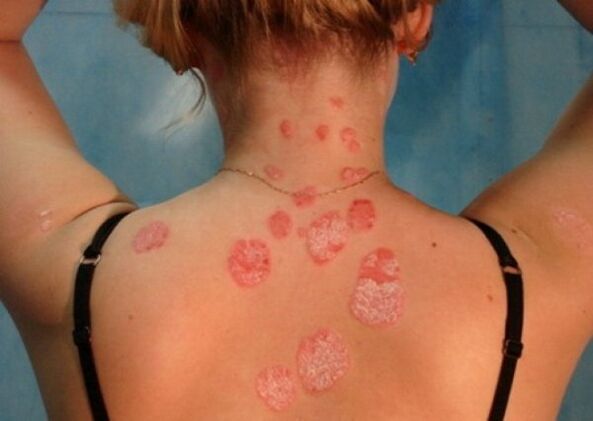
Psoriasis (also known as lichen scale) is a non-contagious, chronic skin disease that recurs frequently.
Psoriasis, whose symptoms determine its propensity to damage the tissues around the joints, manifests itself in the form of scaly papules, and it is worth noting that this disease is one of the most common skin lesions that occurs at any age.
The etiology of this disease has not been fully studied and proven, however, many dermatologists still agree that psoriasis is a disease directly related to hereditary genetic disease.
Do not self-medicate. See your doctor at the first sign of illness.
General description
Psoriasis is characterized by the duration and persistence of its own course. Meanwhile, his period of remission may have been months or years, indicating his subsequent return and lifetime duration. Spontaneous cure for this disease is extremely rare.
If you try to identify a specific group of people who are predisposed to psoriasis, the solution will not be clear. The truth is that psoriasis, as a systemic process, develops not only in people with actual immune disorders, but also in people with certain functional or morphological disorders related to the functioning of various systems and organs.
Psoriasis belongs to the group of skin diseases and is one of the most studied diseases in it. At the same time, the nature of the disease cannot be completely determined by any hypothesis that exists today. Given this, the issues related to his treatment and prevention are in the same uncertain situation as before, and at the same time an emergency. Various ideas about the origin of psoriasis have been proposed, depending on the specific time period. This, in turn, led to the selection of multiple modalities, each based on the results of certain laboratory studies and clinical observations.
- The genetic nature of the disease. This means that the presence of psoriasis in the framework of considering the generations, and thus the cases of this disease are noted. By the way, heredity is actually considered the main and reliable cause of the development of psoriasis (in this case, psoriasis increases under the influence of various predisposing factors).
- The metabolic nature of the disease. In this context, consider disorders of fat metabolism (i. e. cholesterol metabolism), decreased incidence during starvation, increased phosphorus content in psoriatic scales, etc.
- The viral nature of the disease. In this context, the notion that viral infection is directly involved in the etiology of the disease under consideration was developed on the basis of numerous long-term clinical observations. So, for the same reason, the infectious (as well as viral) nature as a theory for the development of psoriasis is the oldest. Thus, at the end of the 19th century, a very broad group of psoriasis types was formed in the context of patients suffering from diseases such as scarlet fever and influenza. The systemic, recurrent and prolonged course of actual lesions, the association with meteorological and heliophysical factors, and certain features inherent in the evolution of psoriatic rashes also confirm the contagious nature of psoriasis. disease. For now, the search is now for those viral agents that can trigger the psoriasis process.
- The endocrine nature of the disease. Many support the theory that there is a direct link between the recent onset of psoriasis and the endocrine (as well as metabolic) nature. Certain endocrine disorders are frequently identified when examining patients with psoriasis, which provides evidence for the relevance of this link. Particular emphasis is placed on disorders related to the functional state inherent in the gonads, the effects of the menstrual cycle, pregnancy, childbirth and lactation, and the types of distinct changes detected in studies of the patient's pituitary-adrenal system.
- Neurogenicity of the disease. It includes the onset of the disease (more precisely, after metastasis) in the context of the patient's actual neurological shock. In about 30% of cases, the worsening of the disease occurs on the basis of stress. In this case, the patient's ability to withstand the effects of stress and subsequently transfer its consequences is reduced. At the same time, the diseases they have (weakness, vegetative viscera, vegetative vascular dystonia, and asthenic depression) combine with neurotic responses to trigger the formation of an epidemic vicious circle, and even exacerbate its characteristics.
Classification
As we have already noted, psoriasis is a chronic and relapsing disease. Any of its existing forms can be attributed to one of the taxonomic variants associated with psoriasis, in which there is a distribution of pustular or non-pustular psoriasis. Generally, the classification is as follows:
- Pustular psoriasis
- Generalized psoriasis;
- Psoriasis annulare (pustulosis annulare);
- Palmoplantar psoriasis (extremity psoriasis, persistent palmoplantar pustulosis, Barbera pustular psoriasis);
- Chronic forms of persistent acrodermatitis (plantar and palmar psoriasis, palmoplantar psoriasis);
- Psoriasis herpetiformis pustulosis.
- non-pustular psoriasis
- psoriasis vulgaris or psoriasis vulgaris, simple psoriasis (plaques, chronic stable psoriasis);
- Psoriatic erythroderma (erythrodermic psoriasis).
Many authors insist that this classification needs to be supplemented, as types or forms of psoriasis can be added to the following variants:
- Seborrheic psoriasis (seborrheic psoriasis);
- napkin psoriasis;
- drug-induced psoriasis;
- "Reversible psoriasis" (psoriasis on the surface of the skin folds, flexors).
Psoriasis: Symptoms
The first symptom of psoriasis is a rash of miliary papules, characterized by a gradual increase along the periphery, as they transform into nummular and lenticular papules and merge into one another, resulting in plaques of varying sizes. The development of psoriasis within the skin defines three main stages.
The first stage
This stage is defined as a progressive one, which is caused by new formations (pimples, actually) on the skin and an increase in size of those already on the skin. This is also accompanied by the formation of an erythematous border around the lesion (this border is defined as a peripheral growth area). Plaques along the edges are less prone to exfoliation, and exfoliation, the final stage of inflammation, cannot keep up with the growth process of psoriasis formation.

second stage
The second stage defines a quiescent period during which new elements do not appear, however, the size of existing elements in the form of plaques and papules does not change. In general, the appearance of papules can be completed at any stage, so miliary papules, lenticuliform papules, and money-like papules can occur simultaneously in the quiescent phase. Let us explain the three types of pimples listed. Therefore, nummular papules are elements of circular rashes within 15-20 mm in diameter (thus, these papules are also called coin-shaped). Lenticular papules, in turn, are elements of a rash that are flat or raised, oval or round, and resemble lentils. Finally there are the miliary papules, which have conical elements and thus resemble cannabis seeds. Basically, these pimples are small in size and the main area is near the hair follicles.
The third phase
This phase is reversed (or backward). Its main feature is the gradual disappearance of the rash and the formation of a white pseudosclerotic border (defined as a Voronov border) around the lesion. During this period, some patients may experience mild itching. As for any subjective feelings, most of them are insignificant or not at all.
The appearance of rashes can be seen in any area of the skin, however, they are mainly located in the area of the curved surfaces of the extremities, especially the elbow and knee joints, the sacral area, the scalp (here, especially the area along the edge of hair growth is defined"Psoriasis Crown"). Psoriasis of the head, although its symptoms depend on the severity of its own presentation, does not lead to changes in the structure of the hair and their loss.
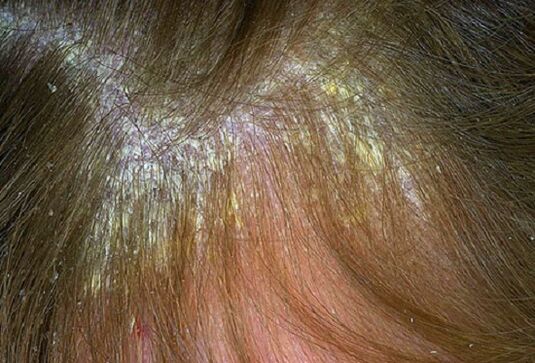
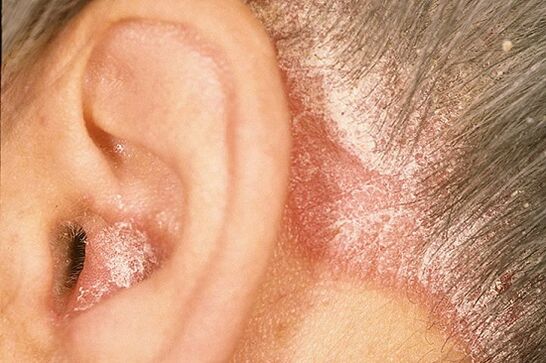
As for the concentration of plaques within the surfaces of the knee and elbow extensor muscles, they usually persist long from the moment the rash generally subsides (this feature defines them as "responsible" plaques). Some patients face the fact that the inguinal-femoral area or the skin folds of the breast and axilla are affected, and this lesion can usually be isolated.
irritant psoriasis
It develops in the context of active exposure to the skin where certain irritants are already present in progressive psoriasis, especially the sun's rays or specific creams, as well as other types of irritants that affect plaque. These patches, in turn, became more bulging in shape and cherry red in color, creating ultra-high temperature zones within the surrounding area, so the sharp boundaries became somewhat blurred. The girdle takes on a puckered appearance as the plaque subsides.
spot psoriasis
This form of the disease is manifested by mild infiltration of the components of the rash (in the general definition, infiltration is the impregnation of tissue with one or another substance). In turn, they look like spots (not pimples). Spotted psoriasis usually develops rapidly and also has similar features to virulence. As the main method of disease identification, the definition of the correspondence between the disease course and its characteristic psoriatic triad was used.
old psoriasis
This form of the disease can be considered a symptom of a severe infiltrating form flanking the plaques, their general cyanosis, with a hyperkeratotic or verrucous surface. Lesions of this type are particularly difficult to cure, and their future transformation into malignancy cannot be ruled out (this is rare, but unfortunately, this option is not necessarily excluded).
Seborrheic psoriasis
As the name suggests, this form of psoriasis occurs in people with seborrhea who have been associated with them. The disease manifests on the scalp, the area behind the pinna, the chest, the nasolabial fold area, the subscapularis and the scapular part of the back. Emerging psoriatic scales are strongly saturated with sebum, so they stick together and remain within the plaque surface, allowing the disease to mimic the picture features of seborrheic eczema.
palmoplantar psoriasis
The disease can manifest itself in the form of ordinary psoriatic plaques and papules, or in the form of hyperkeratotic formations that mimic calluses and calluses. In some cases, psoriasis on the hands, in this case on the palms (or legs - by definition, on the soles) is noted as a continuum of symptoms, which take the form of thickening or keratinization. ThisThese types of lesions are well demarcated; in rarer cases, this form of psoriasis is limited to the appearance of macrocyclic exfoliation.
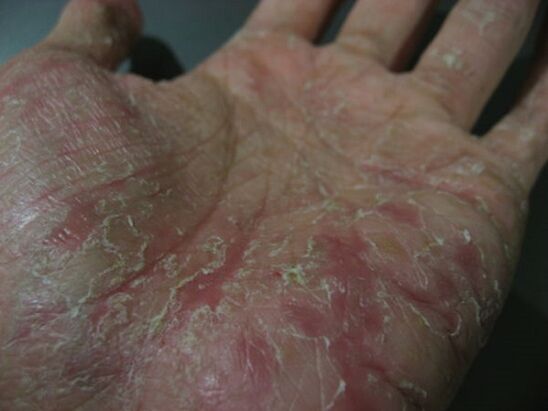
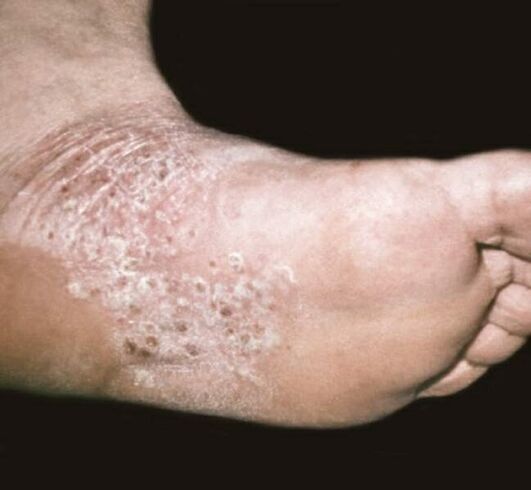
Exudative psoriasis
This form of psoriasis is characterized by excessive exudate during the inflammatory response; it occurs during the advanced stages of the psoriasis course. The exudate reaches the surface of the pimple and saturates the scale buildup, creating a formation that looks like a scab. These elements are secondary, defining them as flaky shells, and the color of these elements is yellowish. After they are removed, slightly bleeding and tearful surfaces are exposed. When the scales dry and delaminate, they often form a large conglomerate resembling an oyster shell (this has been defined as psoriasis).
Guttate Psoriasis
Symptoms of guttate psoriasis appear suddenly and are characterized by the formation of multiple spots within the skin. Most diseases are diagnosed in patients between the ages of 8 and 16. Often, streptococcal infection is a precursor to teardrop psoriasis.
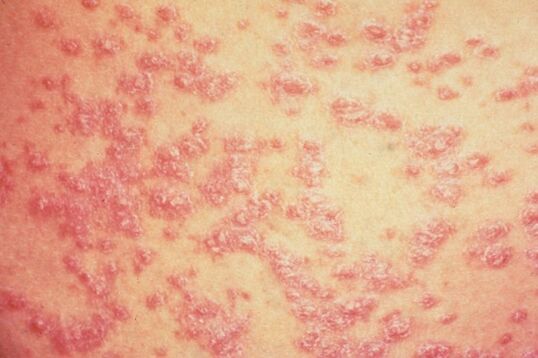
Nail psoriasis
Nail psoriasis, the symptoms of which provide isolation of the three main forms of this psoriasis, which can be atrophic, spotty, or hypertrophic, depending on the extent of the nail damage.
Punctate lesions are thought to be punctate depressions on the nail plate, which can also be compared to the surface of a thimble. This psoriasis may manifest in slightly different forms, with a specificity similar to onychomycosis. In this case, within the free edge, the nail plate will discolor, darken, and easily chip without much effort. As a marker for distinguishing psoriasis, an inflammatory border formed along the perimeter of the affected nail plate area was identified. It appears as the edges of papules within the nail bed, visible through the nail plate.
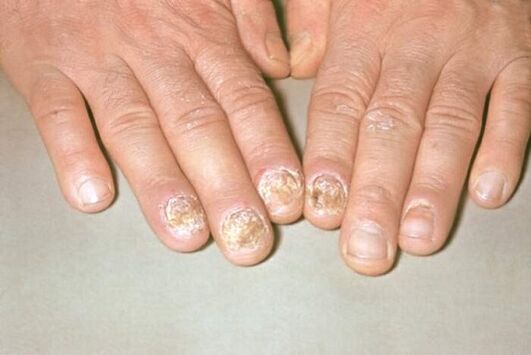
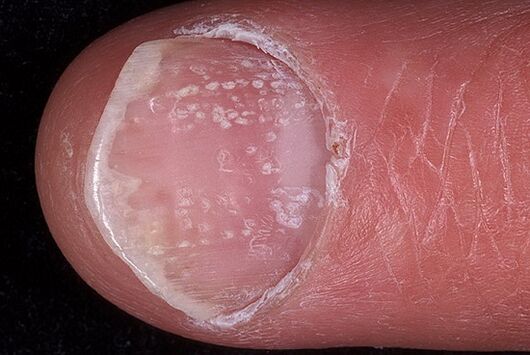
Psoriatic (psoriatic) arthritis
Psoriatic arthritis, which is characterized by infiltration, is associated with tissues around the joints, and also damages the joints, mainly involving the interphalangeal joints. At the same time, the possibility that large joints are involved in the pathological process cannot be ruled out; the joints and joints of the sacroiliac spine are rarely at risk in this regard.
It is important to consider that psoriatic arthritis, unlike other types of arthritis (in the general definition, refers to inflammation of the joints), develops in the context of a patient's pre-existing psoriatic rash, usually associated with nail damage. Combined. Also, it is important to note that this onset of arthritis is combined with the exacerbation of psoriasis within the skin, which in most cases has an exudative character.
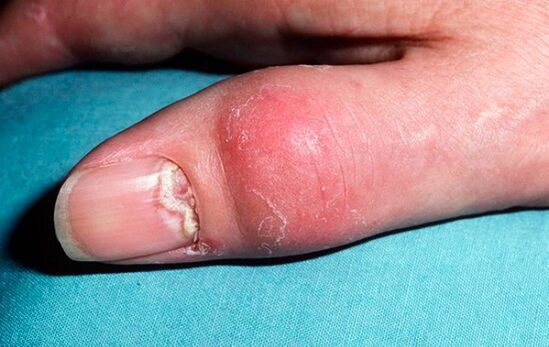
Inappropriate treatment of the disease during disease progression is often accompanied by the development of nonspecific reactions in the body. It is toxic allergy in nature and develops redness in areas not affected by psoriatic plaques, this redness, coalescing, affects the skin entirely. This process is accompanied by an increase in temperature (in the range of 39 degrees or less), as well as increased lymph nodes, skin tightness, burning and itching. In common cases, the nail plate also suffers from extensive flaking, thickening and shedding, and hair loss. This picture already shows the relevance of psoriatic erythroderma. Erythroderma ends by reverting to the traditional version of the psoriasis course.
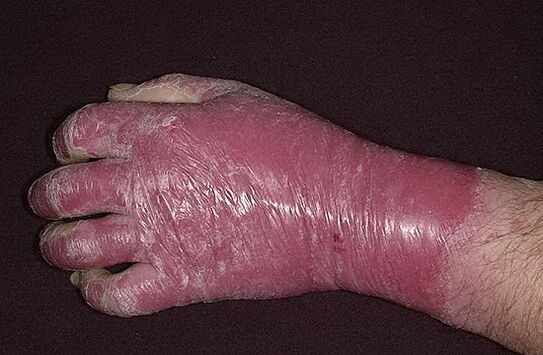
Often, recurrences of the disease occur in the fall and winter as well as in the spring and summer, which is an important factor to consider, including when prescribing the necessary treatment.
Psoriasis Treatment
Before the appointment for treatment, the patient is thoroughly examined and the specific measures in it have been determined, they are based on the stage of the disease process, the clinical diversity, the general condition of the patient, the presence of concomitant diseases, the consistency of the manifestations of the disease with the seasonalityIn other respects, the fastest, at the same time, good therapeutic effects can be achieved for simple psoriasis with a short course of disease, as well as limited manifestations. In general, the treatment of psoriasis is a rather laborious process, and in most cases, a complete cure is not possible - the disease just subsides (i. e. begins a period of existence without symptoms), however, it is also a positive for itresult.
The main goals of treatment were identified as maximal suppression of symptoms combined with preventive measures.
First, for psoriasis, a diet is prescribed, in which those foods that cause the disease to worsen (spicy foods, chocolate, alcoholic beverages) are excluded from the diet. The limit also applies to consumption of bacon, honey, fried and high-fat foods, among others. During the exacerbation period, it is recommended to eat more fruits and vegetables (except red ones: apples, tomatoes, cherries, etc. ), fish and lean meat (boiled).
The course of psoriasis has a beneficial effect on its treatment in sanitary conditions. Given the particular sensitivity of the skin of people with psoriasis, it is recommended to avoid sun exposure for 11 to 16 hours.
As for the drug treatment of psoriasis, it is based on the use of several methods. First, these are topical medicines (creams, ointments, etc. ), systemic treatments (injections, pills, etc. ) and topical treatments such as phytotherapy, physiotherapy. Among them, the most commonly used drugs are as follows:
- Salicylic acid ointment. With its help, the softening of the formed scales is ensured, which in turn offers the possibility of early elimination of them and better absorption of another drug. This ointment (0. 5% or 5%) is applied in a thin layer to the affected skin area 1-2 times a day. An important feature of this application is the use of smaller amounts of ointments with pronounced inflammatory properties (ie, the more pronounced the inflammation is in the nature of its manifestations, the smaller amounts of ointments are used, respectively). Salicylic acid, which is the basis of the drug, alsoFound in many other creams used to treat psoriasis.
- Sulfur Tar Ointment (5% or 10%). Using this ointment reduces inflammatory processes associated with the skin. A contraindication to use is exudative psoriasis (i. e. psoriasis with weeping crusts and scales). You cannot apply this ointment to the skin of the face. Tar shampoo is used to treat scalp psoriasis.
- Naphthalene ointment. It is used to treat the degenerative and quiescent phases of the disease. The exacerbation or progression of psoriasis determines the unacceptability of the use of this therapy. With the help of this ointment, intense itching and inflammation are reduced. Use a 5% or 10% ointment.
- Glucocorticoid drugs. Their use reduces the intensity of inflammation. They are only used in short courses with mandatory supervision by experts.
- Ointment containing vitamin D. This ointment is anti-inflammatory and at the same time improves the course of the disease.
As for systemic therapy, the choice is strictly individual and only by the attending physician. As mentioned earlier, this means using various pills, injections, etc.
As a treatment for psoriasis, phytochemical therapy involves UV light exposure to the affected skin area. For this, a special type of device is used that can irradiate these areas without affecting healthy skin.
In general, the treatment of psoriasis can mean the implementation of many different regimens in practice, but none of these regimens are universally accepted due to their differing course and specificity, so the effectiveness of any regimen cannot be determined for all patientsequally determined. Let us repeat, the treatment of the disease is carried out strictly on an individual basis under the constant supervision of the attending physician.
If symptoms suggestive of psoriasis appear, it is necessary to contact a dermatologist and an infectious disease specialist.























